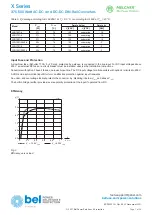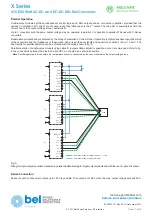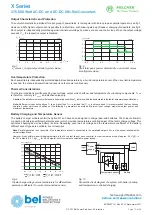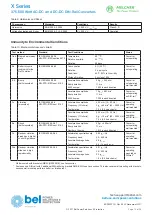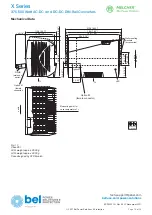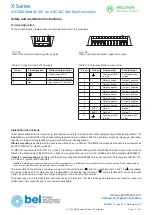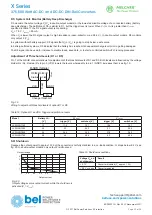
tech.support@psbel.com
belfuse.com/power-solutions
BCD20021-G Rev AF, 29 November 2021
Page 12 of 26
X Series
375, 500 Watt AC-DC and DC-DC DIN-Rail Converters
© 2021 Bel Power Solutions & Protection
Output Characteristic and Protection
The output characteristic, individual for each group of powertrains, is rectangular with a droop to ease parallel operation; see fig. 7.
However, a 50% higher output current is possible for a short time, such allowing start-up of loads or charging of capacitors; see fig. 8.
Each output is independently protected against internal overvoltage by means of a second control loop. When the output voltage
exceeds
V
o L
, the respective output is disabled.
0.8
1.0
0.6
0.4
0.2
0
0
0.2
0.4
0.6
0.8
1.0
1.2
I
o
/I
o nom
V
o
/V
o nom
05181a
1.4
1.6
1.2
1.0
0.8
0.6
-- 0.5
0.5
1.5
2.5 s
I
o
/ I
o nom
05194b
0
1
2
Fig. 7
V
o
versus I
o
(single-output model, typical values).
Fig. 8
Short term peak power characteristic: overcurrent versus
time (typical values).
Overtemperature Protection
Each powertrain is independently protected against over temperature by a built-in temperature sensor. When a certain temperature
is reached, the concerned powertrain reduces its output power continuously.
Thermal Considerations
The thermal conditions are influenced by input voltage, output current, airflow, and temperature of surrounding components.
T
A
max
is therefore, contrary to
T
C max
, an indicative value only.
Caution:
The installer must ensure that under all operating conditions
T
C
remains within the limits stated in the table
Temperature specifications
.
Note:
Sufficient forced cooling allows
T
A
to be higher than
T
A max
provided that
T
C max
is not exceeded. It is recommended that continuous
operation under worst case conditions of the following 3 parameters be avoided: Minimum input voltage, maximum output power, and
maximum temperature.
Battery Charging and Temperature Sensor
The battery charger models exhibit the option M1 and have been designed to charge lead-acid batteries. The R-input allows for
connecting a battery-specific temperature sensor, which provides temperature-controlled adjust of the trickle charge voltage. This
optimizes charging as well as battery life time. Depending upon the cell voltage and the temperature coefficient of the battery,
different sensor types are available; see
Accessories
.
Note
: Parallel operation is not possible, if the temperature sensor is connected to the paralleled outputs Vo+, as the sensor eliminates the
output voltage droop.
However, it is possible to insert bleeding resistors in the Vo+ output lines of each converter in order to create a droop of approx. 0.6 V @
I
o nom
for 24 V outputs (1.2 V @
I
o nom
for 48 V outputs), but this creates considerable power losses.
2.10
2.15
2.20
2.25
2.30
2.35
2.40
2.45
Cell voltage [V]
–20
–10
0
10
20
30
40 50 °C
06139b
V
C
= 2.27 V, –3 mV/K
V
C
= 2.27 V, –3.5 mV/K
V
C
= 2.23 V, –3 mV/K
V
C
= 2.23 V, –3.5 mV/K
V
o safe
Power
supply
Load
–
+
Input
Vo–
R
Temperature sensor
03099d
Battery
Vo+
+
Fig. 9
Trickle charge voltage versus temperature for different tem
-
perature coefficients (V
o safe
with disconnected sensor)
Fig. 10
Schematic circuit diagram of a system with battery backup
and temperature-controlled charging.







